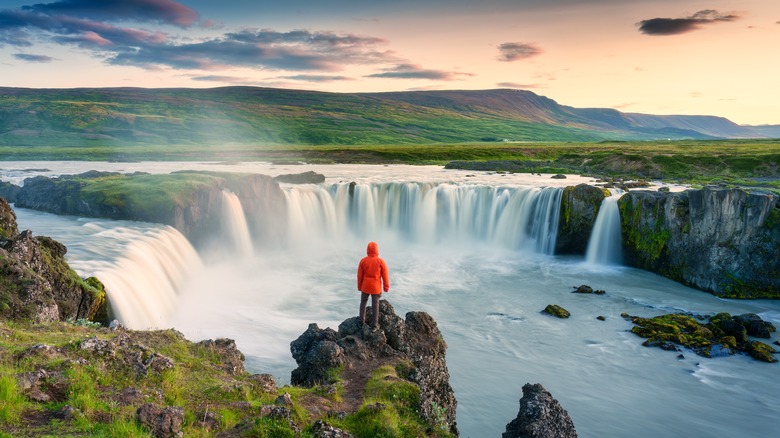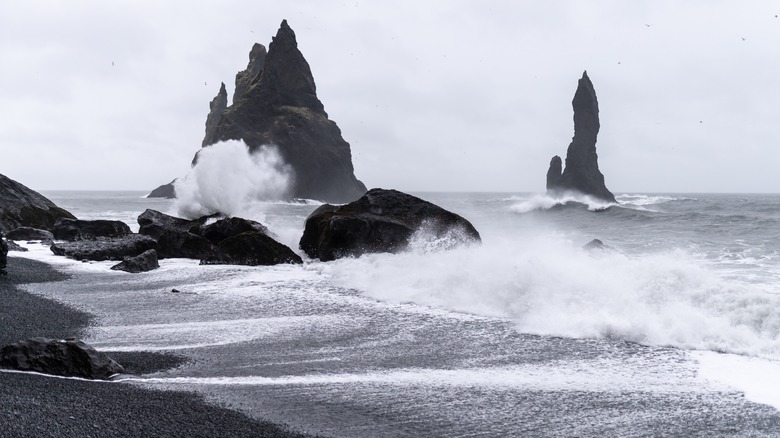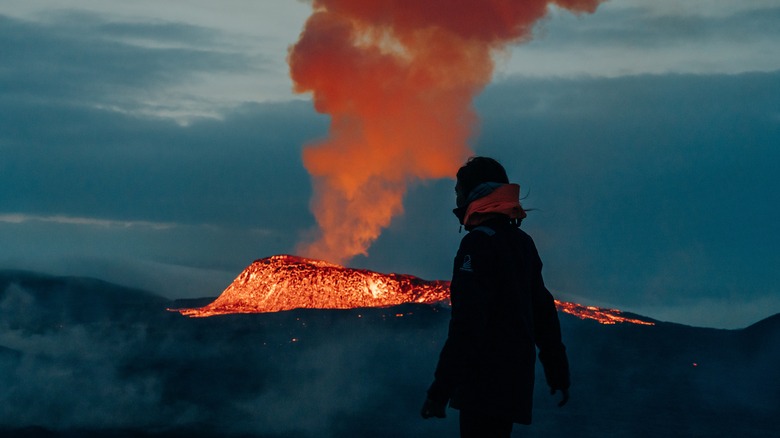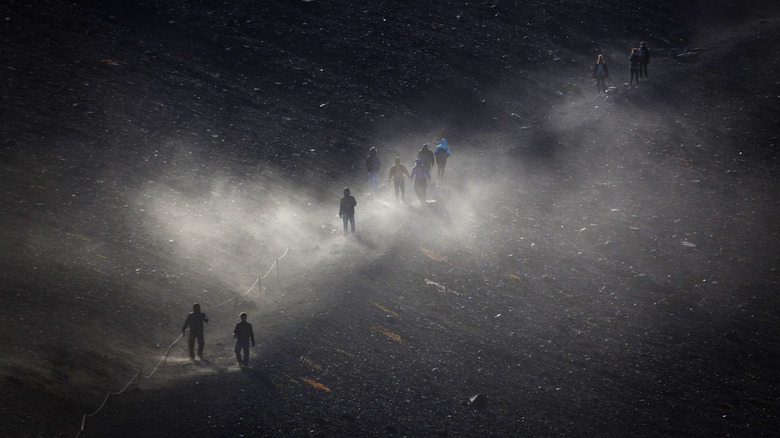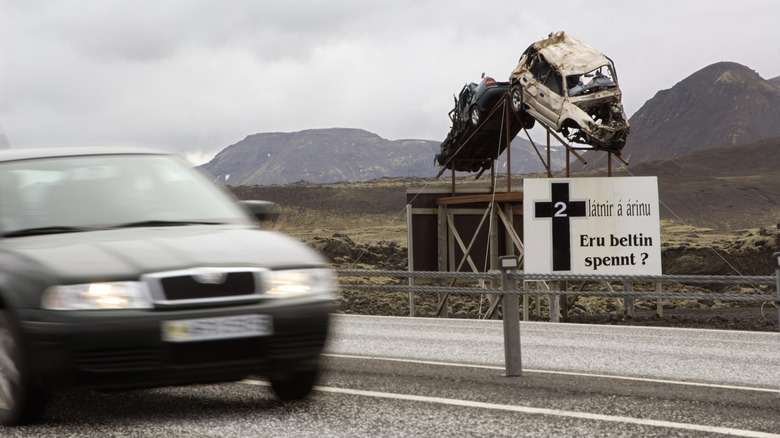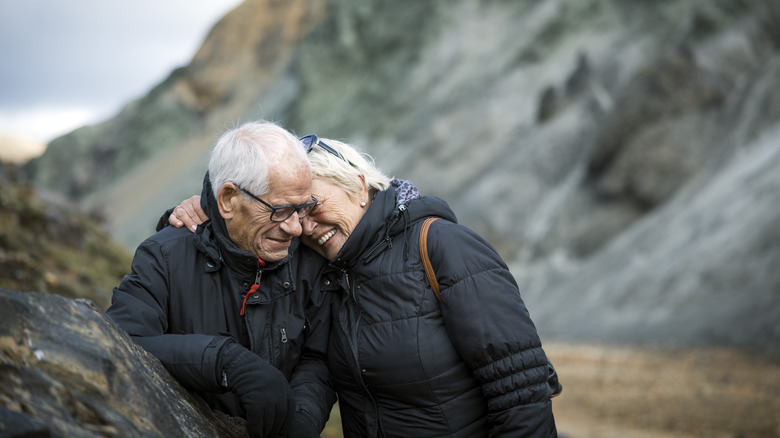Don't Ignore The Sneaky Dangers That Can Kill You In Iceland, According To Rick Steves
Iceland is consistently ranked and celebrated as the safest country in the world. However, the beautiful landscapes that draw nearly 2 million tourists to this country every year also have a not-so-safe side. Contrasting climates, geothermal activity, and challenging driving conditions are just a few of Iceland's sneaky dangers that many travelers may not be aware of, cautions seasoned travel guru Rick Steves. About three tourists perish for preventable reasons in Iceland every year.
Iceland deserves the nickname "the land of fire and ice" for a reason. The island spans 40,000 square miles, sitting between two tectonic plates that are gradually pulling away from each other. As a result of this separation, more than 125 volcanoes and 269 glaciers have been carved into the island, making up 36% of the country. The entire surface of Iceland is made from volcanic rock and is growing by almost an inch every year.
This geothermal activity is one of Iceland's most fascinating features. However, the water in hot springs, geysers, and areas of volcanic activity can reach scalding temperatures of up to 212 degrees Fahrenheit. While popular geothermal attractions like Iceland's Blue Lagoon are carefully managed for visitor safety, Rick Steves cautions on his website that many natural hot springs and geothermal fields in Iceland are located in unregulated areas that may have no fences, walkways, or proper signage. Every one to two years, incidents happen when a tourist sustains severe burns after coming in contact with scorching thermal water.
Winds, storms, and waves
Iceland's weather is capricious, changing from clear skies to storms within minutes. One of its signature features is wind, according to Rick Steves. On good days, wind speeds range between 10 to 15 mph. On bad days, 20 to 40 mph — locals don't leave their homes or go to work on such days. On very bad days, over 70 mph. Because Iceland is relatively barren, there is little forest cover to act as a windbreak. Rick Steves recommends regularly checking the forecast at the Iceland weather service.
Storms are not uncommon. For example, the Highlands experience one storm every 10 days. Blizzards that warrant severe weather warnings happen yearly, leaving behind a trail of destruction. One especially powerful snowstorm in 2022 shut down roads nationwide and Keflavik airport. It literally flipped cars, homes, and people's lives upside down. Ash and sandstorms often occur on the south and east coasts of Iceland. The stormiest season is between September and March.
If you think Iceland's seashores, like in Reynisfjara, will spare you from danger, beware. There's a pretty scary reason you should think twice before visiting Black Sand Beach in Iceland: sneaker waves. Since 2013, these deadly waves have claimed the lives of five people and injured many more. Rick Steves cautions travelers to obey all posted signs and keep their distance from the water. There are no lifeguards on duty, and safety zones are determined by colored lights: Yellow means do not enter the yellow zone, and red means do not go beyond the light sign.
Volcanos, earthquakes, landslides, and avalanches
Iceland is one of the most active volcanic regions in the world, with eruptions occurring roughly every four years. Katla and Bárðarbunga are two of Iceland's largest and most powerful volcanoes, and most notably, Eyjafjallajökull erupted in 2010, causing widespread air travel disruption across Europe. Many of the country's volcanoes can be admired from a distance (emphasis on distance), as they dramatically spew gases, lava, and ash. Volcanic activity can be deadly and interrupt your travels, warns Rick Steves.
If volcanoes aren't enough, earthquakes are another common occurrence in Iceland due to their location on the Mid-Atlantic Ridge, where the North American and Eurasian tectonic plates are moving apart. How common are these earthquakes, you might ask? Around 500 per week. However, most of them are just small shakes. Major destructive earthquakes are rare. The South Iceland Seismic Zone (SISZ), the Tjörnes Fracture Zone (TFZ), and the Reykjanes Peninsula are hotspots for seismic activity.
Landslides, another danger, happen everywhere in Iceland but are most frequent in the Skagafjörður region, the Eastfjords, and the Westfjords. They are usually at their highest trigger risk from August to November and during the springtime snowmelt from May to June. Wintertime travelers to Iceland should be very aware of the potential of avalanches, cautions Rick Steves, especially while traveling in areas close to steep mountain slopes. In 1995, devastating avalanches in the Westfjords killed 34 people.
Hiking dangers
With its diverse and otherwordly landscapes, Iceland is one of the best hiking destinations in the world. Whether you're trekking Laugavegur Pass, Fimmvörðuháls Pass, or any of the other countless potential routes, the recurring trend in Iceland is that no matter how beautiful things are, there is a dangerous side. Hiking is no exception. The terrain can be challenging, with steep ascents, loose rocks, slippery moss, and uneven surfaces. In the winter, the risk is amplified, warns Rick Steves. Countryside paths ice over, and even Reykjavik's city sidewalks aren't properly cleared. Slips and falls are common.
If you're planning to hike Iceland's glaciers, which cover 10% of the country's area, exercise extra caution. Crevasses, seracs (ice towers), and the risk of ice collapse are just some of the dangers. Glaciers may look solid and safe, but this is a deception. They are dynamic, flowing, and melting. Sometimes, these changes happen slowly; other times, quickly and unpredictably. Going with a guide is strongly recommended. Crampons, ice picks, and other essential equipment are also a must when hiking glaciers.
Moreover, many hiking trails in Iceland involve crossing rivers or lagoons that can vary significantly in depth and flow, depending on recent weather. These crossings can be dangerous, particularly when water levels are high due to rain or melting snow. You might be wondering about wildlife dangers — thankfully, Iceland has no native predators, snakes, mosquitos, or even polar bears. However, Arctic terns and other nesting birds can be aggressive towards humans during the breeding season.
Driving dangers
Driving in any new country can be a bit of a learning curve, and in Iceland, there are some unique particularities everyone behind the wheel needs to be aware of. Travelers must familiarize themselves with Iceland's traffic signs and rules of the road. For example, off-road driving is illegal, seatbelts are mandatory, and F-roads (mountain roads) can only be traversed with a 4x4 vehicle. Speed limits are at about 56 miles per hour for a reason — speeding might be tempting, but don't do it.
Rick Steves recommends against driving in the winter, especially outside Reykjavik and the airport area. Even outside winter months, the weather can change rapidly, presenting drivers with sudden snow, ice, wind, and fog. In the winter, it's much worse. Black ice can form on Iceland's famous Ring Road, making driving very treacherous. Narrow, winding roads (common throughout Iceland), including many gravel roads in rural areas, become slippery and difficult to navigate. Additionally, single-lane bridges, blind corners, and free-roaming animals, which can unexpectedly cross over roads, all require drivers to stay constantly vigilant.
Icelandic road trips offer sublime scenery. Viewpoints and opportunities for that perfect photo come at every mile, from glaciers to mountains, grazing horses or sheep. However, Rick Steves cautions against stopping in the middle of the road to take a picture — even if it seems like there's no traffic. Only pull over in a safe location with a designated space. Accidents have happened due to people stopping in the middle of the highway or on the shoulder.
Tips for surviving Iceland
Despite it all, the land of fire and ice is an extremely popular tourist destination. In 2023, there were six times as many visitors (2.2 million people) as there were locals (400,000 Icelanders)! Yet, not many tourists are entirely aware of Iceland's sneaky dangers. Everyone assumes that volcano tourism, glacier climbing, and driving 4x4 vehicles across rivers are perfectly safe because everyone else is doing it. However, it's not so simple. So, how does one survive in Iceland?
Know that 112 is the emergency number. Consider downloading the 112 Iceland app, which allows you to send your location to the emergency services if needed. Rick Steves advises using resources like the Icelandic Meteorological Office and Safetravel.is for up-to-date weather alerts, road conditions, and safety advice. Also, ensure you have comprehensive travel insurance that covers medical expenses (including evacuation) and incidents related to hiking, ice caving, and other adventure activities. Take extra caution in the wintertime, or better yet, avoid wintertime travel in Iceland altogether. Plan your itineraries thoughtfully, but also be prepared for the unexpected.
Come equipped. Bring many layers that can be easily added or removed. Waterproof and windproof clothing is a must, regardless of the season. Don't forget sturdy hiking boots, hiking sticks, and other tactical equipment (offline maps, portable chargers, etc.). Don't take a vacation to Iceland without these essential travel hacks and Rick Steves' indispensable advice: It's a beautiful (and dangerous) country, so enjoy it responsibly and travel safely.
